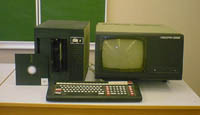
Pavel Verevkin has pointed me at an interesting computer named the Iskra 226. It was a cloned and enhanced Wang 2200 computer, made in the Soviet Union. Pavel says about the Iskra-226 (combining two emails into one message):
Maybe you will be interested in some additional info I have. The Wang 2200 was cloned (with some apparent modifications) by the Soviet Union and was produced as "Iskra 226". Here is is: http://www.museum.ru/C8008
The fact was just a rumor back then as there were no Internet and there were no widespread access to Western publications. Also the was a rumor that the export of Wang 2200 to the Eastern block was prohibited by COMCON (Coordinating Committee on Multilateral Export Controls), and the computer design was apparently stolen by Soviet intelligence.
I worked with the "Iskra 226" in 80s a lot - actually it was pretty popular at least in some parts of Soviet Union. The were several modifications of it. The model I worked with had 128K of RAM - 64K was used for processor code (the T-BASIC interpreter resided there after being loaded from hard drive), and another 64K was used as a data storage (including T-BASIC program and data). Is it different from Wang 2200?
Also I found on your site the following text:
Stupid Trick #7 -- Microcode Abuse
The $GIO instruction allows executing synthetic microcode programs for performing fast I/O to peripherals, such as serial ports and reel-to-reel tape drives. However, they keyboard and display are just peripherals as far as the microcode is concerned. With some cunning, I'm sure some interesting feats could be achieved, such as high speed screen drawing, but I must admit to just speculating here. Some rainy day I'll make an attempt and report my results here.
Actually, "Iskra 226" I dealt with had unique vector graphic controller (with commands very similar to a plotter) which allowed to draw vector graphics to the display (which was usually character) right alongside character data. I never saw anything like this before or after - was it stolen from Wang too or something else? Anyway, I used direct microcode output (not sure about $GIO syntax) to make animation with the vector commands (and code 03 - clear screen) - a little running man. That was all performance allowed to do with the real graphics, so my real games on the computer were made with pseudographics (X and Y for the running man).
The Iskra 226 was produced in USSR by "Schetmash" in Kursk, Russia. This is their history page: http://www.schetmash.ru/index.php?p=184 [Ed. note: dead link now].
The line near "year 1985" states:
USSR state prize for personal computer "Iskra 226" was won by V.I.Shuteev and F.A.Bubalo.Hope this shed a little bit of a new light at the interesting nostalgic theme.
Pavel Verevkin
Here is the Russian Wikipedia entry on the Iskra-226 (autotranslated to English).
Here is a Russian web page about the Iskra-226 (autotraslanted to English).
I've scanned the book ПРОГРАММИРОВАНИЕ НА МИКРОЗВМ ИСКРА 226 (Programming for Micro Computer Spark-226), by V.E.Balasanian, S.V.Bogdukevich, and V.A.Shakhverdov (268 pages, 13MB). Be forewarned it is written in Russian.
Here is another book on the Iskra-226, Personal Computer ISKRA-226 Architecture and Software Reference Manual by V.Z.Aladiev, Ya.G.Martynenko, and V.F.Shilenko (156 pages, 15.4 MB). It, too, is written in Russian. Thanks to Pavel Verevkin for translating the title and authors.
For both books above, neither the publisher nor the authors have given me permission to share them, as I can't figure out how to contact them to ask permission. If they object to having these online, of course I will take them down. Considering how old it is and there is no market left for this information, I hope this is OK and ask for forgiveness if I'm wrong.
This Google Books link is to Advances in computers, Volume 29, by Marshall C. Yovits. Here is the small section about the Iskra-226, on page 297-298:
The ISKRA 226 is a WANG-2200 work-alike. The first half dozen WANG- 2200 machines produced were exported ot the Soviet Union in 1972 and 1973 and many more followed them during the remainder of the decade. In total, about 2000 were shipped to the USSR and Eastern Europe and they became very popular as planner's workstations. The tightening of U.S. and COCOM export restrictions in the wake of the Afghanistan invasion not only ended WANG's exports but deprived Gosplan and other central planning agencies of their supplier.
Minpribor's "Schetmash" factory in Kursk had been producing a variety of ISKRA bookkeeping machines in the 1970s. On the basis of that experience, Minpribor designers reverse engineered the WANG-2200 as the ISKRA 226, which entered serial production in 1981. The first copies of the new machine went to Academy of Sciences and Gosplan and by 1985 more than 800 ministries and departments were using it. The ISKRA 226.7 is shipped with a variety of Soviet, Bulgarian, and East German peripherals in at least seven main configurations. Their prices vary between 11 and 25 thousand rubles ($18000-$42000). Most of the software has been developed by Gosplan. So pleased were the authorities with Minpribor's work that Academician Velikhov nominated the machine's designers for the 1985 State Prize.
If anybody out there has any documents on the Iskra-226, please contact me to help this page grow.
